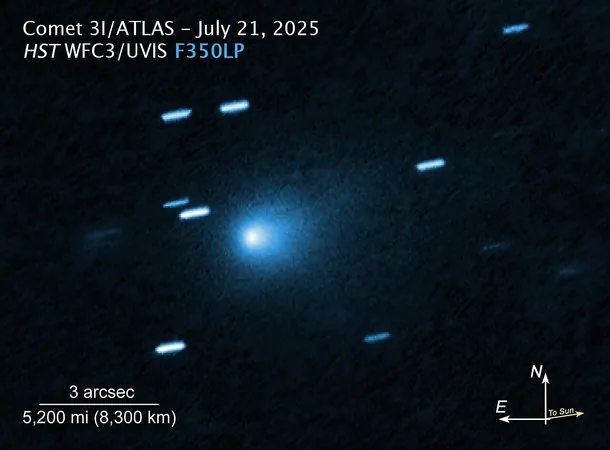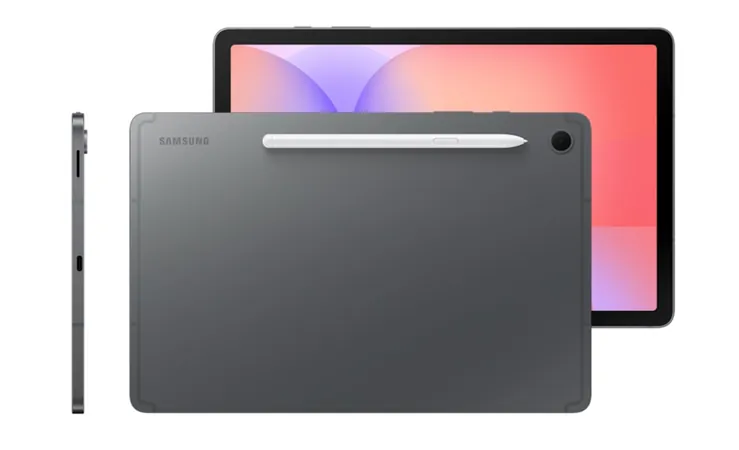
Unlocking the Secrets of Interstellar Comets: A Bold New Mission Concept
2025-09-06
Author: William
A Cosmic Sensation: The Discovery of 3I/ATLAS
In July, the astronomical community buzzed with excitement as the interstellar comet 3I/ATLAS made its debut, marking the third interstellar visitor to our Solar System since 1I/'Oumuamua and 2I/Borisov. These cosmic wanderers, arriving in 2017 and 2019 respectively, reveal the frequent interactions we have with objects from beyond our stellar neighborhood.
The Research Breakthrough from SwRI
Now, researchers at the Southwest Research Institute (SwRI) have introduced an innovative mission concept aimed at closely examining 3I/ATLAS. This potential spacecraft flyby could unlock transformative insights into not only this comet but also the environments of other star systems.
Why Study Interstellar Objects?
Asteroids and comets are remnants from the dawn of our Solar System, over 4.6 billion years ago. By studying interstellar objects (ISOs), we can glean valuable information about the conditions in distant star systems without having to travel light-years to explore them. The SwRI team's new study not only offers a feasible design for a flyby mission but also outlines scientific objectives and critical requirements for gathering data on 3I/ATLAS.
Led by Visionary Dr. Alan Stern
At the helm of this ambitious initiative is Dr. Alan Stern, a renowned planetary scientist known for leading the historic New Horizons mission, which performed the first-ever flyby of Pluto in 2015. Stern previously spearheaded a concept study for an Interstellar Object Explorer and now aims to further our understanding of ISOs through this proposed Interstellar Comet Explorer (ICE).
A Unique Window into Stellar Origins
Stern emphasizes that ISOs present a unique opportunity to study celestial bodies formed in other star systems up close. An ICE flyby could deliver groundbreaking insights into the structure and composition of these objects, significantly enhancing our comprehension of solid-body formation processes in a cosmic context.
Innovative Trajectory and Mission Design
One challenge facing the mission is the impossibility of placing the spacecraft in orbit around an ISO due to their high-speed trajectories. However, the SwRI analysis reveals that a flyby mission is not only feasible but also cost-effective, promising substantial scientific benefits. Using advanced software, the team calculated low-energy trajectories that would allow the spacecraft to reach and analyze 3I/ATLAS.
Exciting Prospects for Scientific Discovery
With the simulations confirming a possible low-energy rendezvous, the ICE could collect significant data with less propulsion power compared to many current robotic missions. Dr. Mark Tapley, an expert in orbital mechanics at SwRI, noted that the mission would utilize technologies already proven in existing NASA missions, making the endeavor largely attainable.
Amazing Findings Await!
The anticipated scientific returns from the ICE mission are monumental. As 3I/ATLAS approaches the Sun, its icy surface will sublimate, forming a tail and a coma. The spacecraft could analyze these features with spectrometers, unraveling secrets about the comet’s composition and the very forces that shaped its existence.
A Thrilling Future for Interstellar Exploration
Matthew Freeman, the project manager at SwRI, remarked on the exciting possibilities: "The trajectory of 3I/ATLAS is interceptable by our mission design, and observations during a flyby could revolutionize our understanding of interstellar objects." Given that studies suggest around seven ISOs pass through our inner Solar System each year, this mission could pave the way for future exploration of countless cosmic vagabonds.
The Dawn of a New Era in Astronomy
As advanced facilities like the Vera Rubin Observatory unveil thousands of new objects, astronomers remain hopeful for the discovery of more ISOs. The ICE mission represents a monumental leap toward understanding the mysteries that lie beyond our Solar System—and who knows what treasures await us in the depths of space!









 Brasil (PT)
Brasil (PT)
 Canada (EN)
Canada (EN)
 Chile (ES)
Chile (ES)
 Česko (CS)
Česko (CS)
 대한민국 (KO)
대한민국 (KO)
 España (ES)
España (ES)
 France (FR)
France (FR)
 Hong Kong (EN)
Hong Kong (EN)
 Italia (IT)
Italia (IT)
 日本 (JA)
日本 (JA)
 Magyarország (HU)
Magyarország (HU)
 Norge (NO)
Norge (NO)
 Polska (PL)
Polska (PL)
 Schweiz (DE)
Schweiz (DE)
 Singapore (EN)
Singapore (EN)
 Sverige (SV)
Sverige (SV)
 Suomi (FI)
Suomi (FI)
 Türkiye (TR)
Türkiye (TR)
 الإمارات العربية المتحدة (AR)
الإمارات العربية المتحدة (AR)